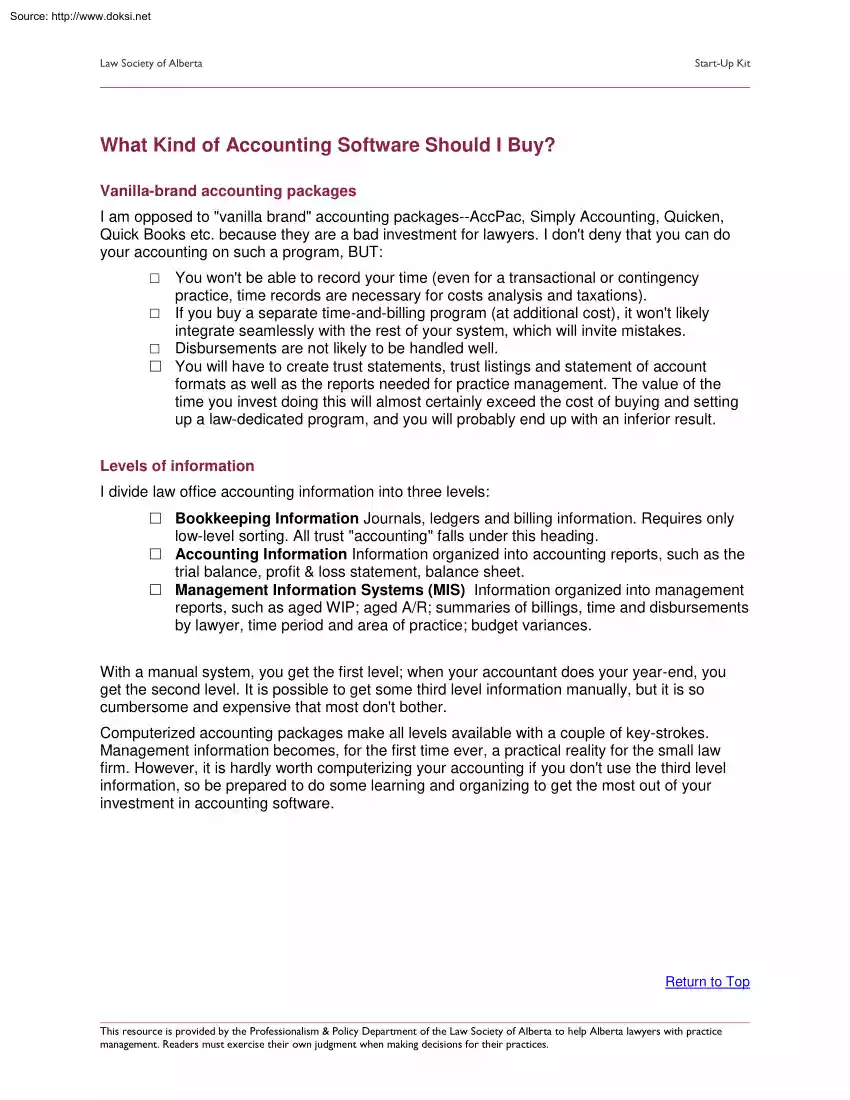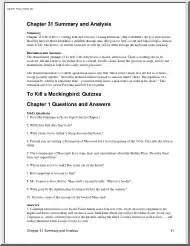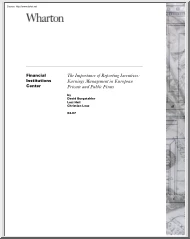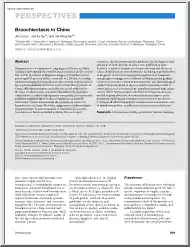Please log in to read this in our online viewer!

Please log in to read this in our online viewer!
No comments yet. You can be the first!
What did others read after this?
Content extract
Source: http://www.doksinet Law Society of Alberta Start-Up Kit What Kind of Accounting Software Should I Buy? Vanilla-brand accounting packages I am opposed to "vanilla brand" accounting packages--AccPac, Simply Accounting, Quicken, Quick Books etc. because they are a bad investment for lawyers I don't deny that you can do your accounting on such a program, BUT: □ You won't be able to record your time (even for a transactional or contingency practice, time records are necessary for costs analysis and taxations). □ If you buy a separate time-and-billing program (at additional cost), it won't likely integrate seamlessly with the rest of your system, which will invite mistakes. □ Disbursements are not likely to be handled well. □ You will have to create trust statements, trust listings and statement of account formats as well as the reports
needed for practice management. The value of the time you invest doing this will almost certainly exceed the cost of buying and setting up a law-dedicated program, and you will probably end up with an inferior result. Levels of information I divide law office accounting information into three levels: □ Bookkeeping Information Journals, ledgers and billing information. Requires only low-level sorting. All trust "accounting" falls under this heading □ Accounting Information Information organized into accounting reports, such as the trial balance, profit & loss statement, balance sheet. □ Management Information Systems (MIS) Information organized into management reports, such as aged WIP; aged A/R; summaries of billings, time and disbursements by lawyer, time period and area of practice; budget variances. With a manual system, you get the first level; when your accountant does your year-end, you get the second level. It is possible to get some third level information
manually, but it is so cumbersome and expensive that most don't bother. Computerized accounting packages make all levels available with a couple of key-strokes. Management information becomes, for the first time ever, a practical reality for the small law firm. However, it is hardly worth computerizing your accounting if you don't use the third level information, so be prepared to do some learning and organizing to get the most out of your investment in accounting software. Return to Top This resource is provided by the Professionalism & Policy Department of the Law Society of Alberta to help Alberta lawyers with practice management. Readers must exercise their own judgment when making decisions for their practices Source: http://www.doksinet Law Society of Alberta Start-Up Kit
Shopping for an accounting package Here's what I recommend you keep in mind when shopping for a law office accounting package: Bookkeeping □ Trust done the way the Law Society requires, which means a chronological journal, individual client trust ledgers, a trust transfer journal and the ability to produce a trust listing □ Electronic trust and general account reconciliation. □ Disbursements done as painlessly as possible, with the option to treat them as recoverable expenses or as assets. □ Timekeeping that is easy and that allows work to be posted on either an hourly rate or a block fee basis. □ Multiple, flexible account formats that draw together the trust, timekeeping and disbursements information for easy review, editing and posting. □ Easy, intuitive posting of both simple and complex trust and general entries. □ Automatic GST calculation and reports. □ Clear and understandable trust statements, account receivable ledgers
and statements of account that can be printed in a form that can sent to clients without being retyped. Accounting □ Full range of general ledger accounts (assets, liabilities, proprietor/partnership capital, revenue and expenses), with complete flexibility to customize account numbers and names. □ Year end posting. □ Ability to generate trial balance, balance sheet and P&L. MIS □ Quick, easy-to-access client/matter summary showing time, disbursements and trust information. □ Budget function. □ Reports as mentioned above. □ Control over which reports will be printed and when. Additional features □ □ □ □ □ □ □ Easy to learn and use. Rapid entry codes to facilitate posting. Understandable documentation. Good support (especially when you are converting to the new program). Networkable. Limitations and deadlines. Automatic conflicts checking. Return to Top
This resource is provided by the Professionalism & Policy Department of the Law Society of Alberta to help Alberta lawyers with practice management. Readers must exercise their own judgment when making decisions for their practices Source: http://www.doksinet Law Society of Alberta Start-Up Kit □ □ Integration with spreadsheet to produce graphs and charts. Client information that integrates with other programs (e.g, to produce a merge data file of client addresses in WordPerfect, or with a case management program like Amicus Attorney). Multi-level password control. □ A large base of satisfied users (when shopping, ask for a list of users in your area and call them to see what they have experienced using the program). Value commensurate with price. The transition It takes a while to get a computerized accounting system working well. You will
probably make some mistakes in the initial set-up because it will all be so new, so don't go cold turkey. I recommend that you run your old manual system in parallel with the new computerized system for at least 2 months to allow you to make a step-by-step transition. When you have a good handle on the new system, dump it and start over, this time with some experience. Return to Top This resource is provided by the Professionalism & Policy Department of the Law Society of Alberta to help Alberta lawyers with practice management. Readers must exercise their own judgment when making decisions for their practices
needed for practice management. The value of the time you invest doing this will almost certainly exceed the cost of buying and setting up a law-dedicated program, and you will probably end up with an inferior result. Levels of information I divide law office accounting information into three levels: □ Bookkeeping Information Journals, ledgers and billing information. Requires only low-level sorting. All trust "accounting" falls under this heading □ Accounting Information Information organized into accounting reports, such as the trial balance, profit & loss statement, balance sheet. □ Management Information Systems (MIS) Information organized into management reports, such as aged WIP; aged A/R; summaries of billings, time and disbursements by lawyer, time period and area of practice; budget variances. With a manual system, you get the first level; when your accountant does your year-end, you get the second level. It is possible to get some third level information
manually, but it is so cumbersome and expensive that most don't bother. Computerized accounting packages make all levels available with a couple of key-strokes. Management information becomes, for the first time ever, a practical reality for the small law firm. However, it is hardly worth computerizing your accounting if you don't use the third level information, so be prepared to do some learning and organizing to get the most out of your investment in accounting software. Return to Top This resource is provided by the Professionalism & Policy Department of the Law Society of Alberta to help Alberta lawyers with practice management. Readers must exercise their own judgment when making decisions for their practices Source: http://www.doksinet Law Society of Alberta Start-Up Kit
Shopping for an accounting package Here's what I recommend you keep in mind when shopping for a law office accounting package: Bookkeeping □ Trust done the way the Law Society requires, which means a chronological journal, individual client trust ledgers, a trust transfer journal and the ability to produce a trust listing □ Electronic trust and general account reconciliation. □ Disbursements done as painlessly as possible, with the option to treat them as recoverable expenses or as assets. □ Timekeeping that is easy and that allows work to be posted on either an hourly rate or a block fee basis. □ Multiple, flexible account formats that draw together the trust, timekeeping and disbursements information for easy review, editing and posting. □ Easy, intuitive posting of both simple and complex trust and general entries. □ Automatic GST calculation and reports. □ Clear and understandable trust statements, account receivable ledgers
and statements of account that can be printed in a form that can sent to clients without being retyped. Accounting □ Full range of general ledger accounts (assets, liabilities, proprietor/partnership capital, revenue and expenses), with complete flexibility to customize account numbers and names. □ Year end posting. □ Ability to generate trial balance, balance sheet and P&L. MIS □ Quick, easy-to-access client/matter summary showing time, disbursements and trust information. □ Budget function. □ Reports as mentioned above. □ Control over which reports will be printed and when. Additional features □ □ □ □ □ □ □ Easy to learn and use. Rapid entry codes to facilitate posting. Understandable documentation. Good support (especially when you are converting to the new program). Networkable. Limitations and deadlines. Automatic conflicts checking. Return to Top
This resource is provided by the Professionalism & Policy Department of the Law Society of Alberta to help Alberta lawyers with practice management. Readers must exercise their own judgment when making decisions for their practices Source: http://www.doksinet Law Society of Alberta Start-Up Kit □ □ Integration with spreadsheet to produce graphs and charts. Client information that integrates with other programs (e.g, to produce a merge data file of client addresses in WordPerfect, or with a case management program like Amicus Attorney). Multi-level password control. □ A large base of satisfied users (when shopping, ask for a list of users in your area and call them to see what they have experienced using the program). Value commensurate with price. The transition It takes a while to get a computerized accounting system working well. You will
probably make some mistakes in the initial set-up because it will all be so new, so don't go cold turkey. I recommend that you run your old manual system in parallel with the new computerized system for at least 2 months to allow you to make a step-by-step transition. When you have a good handle on the new system, dump it and start over, this time with some experience. Return to Top This resource is provided by the Professionalism & Policy Department of the Law Society of Alberta to help Alberta lawyers with practice management. Readers must exercise their own judgment when making decisions for their practices




 Just like you draw up a plan when you’re going to war, building a house, or even going on vacation, you need to draw up a plan for your business. This tutorial will help you to clearly see where you are and make it possible to understand where you’re going.
Just like you draw up a plan when you’re going to war, building a house, or even going on vacation, you need to draw up a plan for your business. This tutorial will help you to clearly see where you are and make it possible to understand where you’re going.